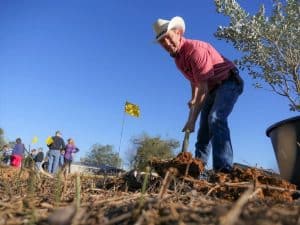From the Ashes
From the Ashes
By Jaclyn Robertson [Dec. 4, 2018]
Our District is deeply rooted in the natural landscape and the boundaries of our communities extend to the soils, water, plants, and wildlife that support us. Our Post Oak Savannah ecoregion is unique only to Texas and contained entirely within the state, known for open plains of tallgrasses and scattered clusters of oak trees. But did you know our tall grasslands and clustered oaks were created and maintained by historic fire regimes?

Image credit: http://www.usgwarchives.net/tx/milam/photos/schools/milamview.jpg
Tallgrass prairies naturally collect a large amount of biomass, or dead plant material, in the fall as they die off to prepare for winter dormancy. Over time this layer of biomass eventually breaks down into the soil enough to become new organic material for uptake by plants.
“A steer could gain almost 2 pounds per day feeding on bluestem grass of the Savannah prairie.”[1]

Image courtesy of: Kubiak, L. Texas History Series. [3]
Fire was a way to speed up this breakdown process by turning dead material into available nutrients in a matter of seconds! Fires were started naturally by lightning strikes, or by Native Americans who used fire to clear understory for travel and improve gathering conditions. These fires were sometimes referred to as, “Red Buffalo,” because it cleared land and distributed grass seeds to benefit the range in the same way as a herd of grazing buffalo. This fire regime created the incredibly fertile grasslands that our Post Oak Savannah has always been known for and which attracted the first settlers to our area. [2]
Over time, reduction of fire and fragmentation of families’ land tracts over the years have left only small patches of true Savannah grasslands in Central Texas. As a result, landowners struggle with brush encroachment on working lands, gullies deepened by erosion, and declining water quality. The good news is things like rainwater harvesting and planting native species (trees, shrubs, and vines) can improve these.
Rainwater harvesting not only takes pressure off our aquifers, but it helps reduce the speed and amount of heavy rain that runs across rangelands widening gullies and moving too much of our soils into rivers [4] [5].

Image Courtesy Doug Box, 2018.
Planting trees, shrubs, and vines are important to water quality and erosion, acting as a natural filter for rainwater as it passes through layers of soil and roots that hold soil in place. Native species in particular can benefit planters by requiring less time and money. These species are naturally the best equipped to handle the grassland’s weather patterns, meaning that they require less water, pesticides, and fertilizers to thrive.
“Native plants require less water than lawns and help prevent erosion.” USDA Forest Service. [6]
Attendees learned all this and more, including how to best select plants and best locations for planting at the workshop held Nov. 16th. An indoor portion was taught by Specialist Tim Hartmann of the Horticultural Dept. at Texas A&M AgriLife Extension Service followed by an outdoor portion led by Clover Cochran Sculpture. A Rainwater Harvesting Workshop was held in October and another is in the works for those interested in learning more. We are grateful to our friends at Agrilife and members of our community who make these events possible. Post Oak Savannah Groundwater Conservation District and the Board of Directors look forward to working more with our neighbors to conserve our unique landscape and resources.
Additional resources about planting and gardening provided by Agrilife Extension Service can be found here.

